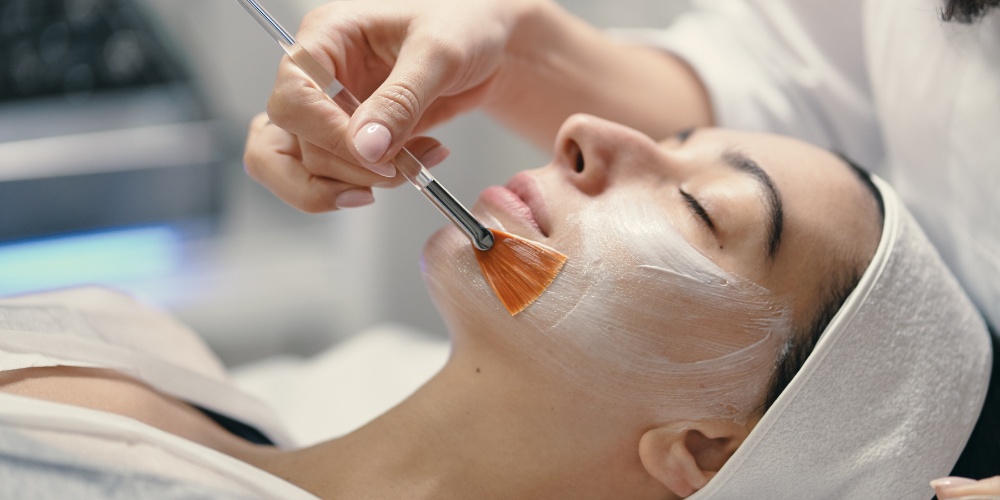If you’re on a quest for radiant, youthful skin, chemical exfoliation might just be your secret weapon. With the myriad of skincare options available, it’s essential to understand the magic behind the acronyms: AHA, BHA, and enzyme peels. These powerful treatments have revolutionized skincare routines, offering gentle yet effective ways to unveil your skin’s natural glow. In this article, we’ll dive deep into the world of chemical exfoliation, exploring the differences between AHA, BHA, and enzyme peels while shedding light on their benefits and considerations.
Chemical Exfoliation
Chemical exfoliation is a skincare technique that involves using specific chemical compounds to remove dead skin cells, unclog pores, and promote skin renewal. Unlike physical exfoliants, which often involve abrasive particles, chemical exfoliation works on a molecular level, gently dissolving the bonds between dead skin cells.
Understanding AHAs: A Radiant Revelation
Alpha Hydroxy Acids (AHAs) are water-soluble acids derived from fruits and milk sugars. They are renowned for their ability to gently slough away the top layer of dead skin cells, revealing a brighter and more even complexion beneath. AHAs, such as glycolic acid and lactic acid, are perfect for addressing sun damage, fine lines, and uneven skin tone.
Decoding BHAs: Banishing Imperfections
Beta Hydroxy Acids (BHAs), on the other hand, are oil-soluble acids like salicylic acid. They penetrate deeper into the pores, making them highly effective for individuals with oily and acne-prone skin. BHAs work to exfoliate the inside of the pores, helping to dislodge impurities and reduce the appearance of blackheads and blemishes.
Enzyme Peels: Nature’s Exfoliation
Enzyme peels utilize natural enzymes, often derived from fruits like papaya and pineapple, to gently dissolve dead skin cells. These peels are a fantastic option for individuals with sensitive skin or those seeking a milder exfoliation method. Enzyme peels offer a delicate yet effective approach to achieving smoother and more vibrant skin.
The Marvels of Chemical Exfoliation
The true beauty of chemical exfoliation lies in its versatility and efficacy. Unlike physical scrubs that can be harsh on the skin, chemical peels can be customized to suit different skin types and concerns. They not only promote a youthful appearance but also enhance the absorption of other skincare products, making your entire routine more effective.
Who Can Benefit from Chemical Peels?
Chemical peels cater to a wide range of skin concerns. Whether you’re grappling with dullness, fine lines, acne scars, or uneven texture, there’s likely a chemical peel that can address your specific needs. However, individuals with extremely sensitive skin should proceed with caution and consult a dermatologist before incorporating chemical exfoliation into their routine.
Incorporating Chemical Exfoliation into Your Routine
Introducing chemical exfoliation into your skincare routine requires careful consideration. Start with a patch test to ensure your skin can tolerate the treatment. Initially, incorporate exfoliation into your routine once a week and gradually increase the frequency as your skin becomes accustomed to it.
Preparing Your Skin for Chemical Peels
Before undergoing a chemical peel, it’s crucial to prepare your skin to minimize the risk of irritation. Avoid using retinol and exfoliants for a few days before your treatment, and inform your skincare professional about any allergies or medications you’re taking.
The Application Process: Step-by-Step Guide
Cleansing: Begin with a clean face to ensure maximum penetration of the peel.
Application: Apply the peel according to the product instructions, avoiding the delicate eye and lip areas.
Duration: Follow the recommended duration to avoid overexfoliation.
Neutralization: If required, neutralize the peel as directed by the product.
Rinsing: Gently rinse your face with cool water to remove the peel.
Post-Peel Care: Follow up with a soothing moisturizer and sunscreen.
Post-Peel Skincare: Nurturing Your Renewed Skin
After a chemical peel, your skin needs extra care and protection. Opt for gentle, hydrating skincare products to soothe your skin and promote healing. Additionally, always wear broad-spectrum sunscreen to shield your renewed skin from harmful UV rays.
The Importance of Sun Protection
Sun protection is non-negotiable, especially after exfoliation. Freshly exfoliated skin is more susceptible to sun damage, so ensure you apply sunscreen daily. This step not only prevents sunburn but also maintains the results of your chemical peel.
Addressing Common Concerns and Misconceptions
Chemical peels are painful and require downtime.
Fact: Mild peels might cause slight tingling, but severe discomfort is rare. Most peels have minimal downtime, and any redness usually subsides within a day or two.
Chemical peels are only for mature skin.
Fact: Chemical peels can benefit various age groups and skin concerns, from acne-prone teens to individuals seeking anti-aging solutions.
IICAD Mumbai: You’re Partner in Skincare Education
At the International Institute of Cosmetic and Aesthetic Dermatology (IICAD) Mumbai, we are dedicated to providing comprehensive skincare education. Our experts empower individuals with the knowledge to make informed decisions about their skincare routines, ensuring they achieve the best possible results.
Summary
In the realm of skincare, chemical exfoliation stands as a powerful method to rejuvenate and revitalize your skin. By understanding the differences between AHA, BHA, and enzyme peels, you can tailor your approach to meet your unique skincare needs. Embrace the transformative effects of chemical exfoliation and unlock the radiant, youthful complexion you deserve.

